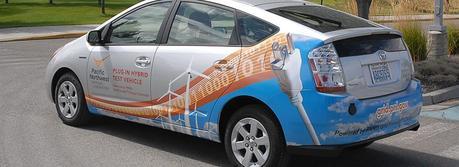
PNNL's Toyota Prius (credit: PNNL)
While the increasing use of electric vehicles carries many benefits, there are some concerns about the effect it would have on the stability of the electrical grid. To solve that problem before it even arises, a new technology is being developed under commercial license agreement between Battelle and AeroVironment, Inc., of Monrovia, Calif. This technology seeks not only to ensure the stability of the electrical grid, but also to lower electricity costs for plug-in car owners.
Battelle operates the Department of Energy’s Pacific Northwest National Laboratory in Richland, Wash. AeroVironment will use a portion of the licensed technology in a new prototype version of its Level II charging systems.
Developed at PNNL, the Grid Friendly EV ChargerController technology tells the car’s battery charger when to start and stop charging based upon existing conditions on the electrical grid. Since electric vehicles can now be charged when electricity is most readily available, the technology could translate into lower bills for vehicle owners and a more stable grid.
AeroVironment’s new prototype EV charging station, incorporating the PNNL technology, will help stabilize the electrical grid by continuously monitoring the grid’s alternating current, or AC, frequency and varying the vehicle charging rate in response. If an unexpected event on the grid causes a rapid drop in the AC frequency, the charging system will stop charging, providing a grid “shock absorber.” Under normal conditions, this stabilizing technology will be particularly important as the power grid is expected to rely more and more on variable renewable resources such as wind and solar technologies.
An earlier PNNL study found America’s existing power grid could meet the needs of about 70 percent of all U.S. light-duty vehicles if battery charging was managed to avoid new peaks in electricity demand.
“If a million owners plug in their vehicles to recharge after work, it could cause a major strain on the grid,” said PNNL lead engineer Michael Kintner-Meyer. “The Grid Friendly Controller could prevent those peaks in demand from plug-in vehicles and enable our existing grid to be used more evenly. And our studies have shown that those who use the technology could save $150 or more a year on their electricity bill, and they could potentially receive rebates for providing shock-absorbing services to the grid operator,” Kintner-Meyer added.
“These technologies will result in a triple-win,” said Alec Brooks, chief technology officer of AeroVironment’s EES business segment. “First, reducing the cost of integrating variable renewable generation reduces the electricity costs for all ratepayers. Second, plug-in cars can be powered by renewable generation that might not have been possible to add to the grid without the charging rate flexibility offered by vehicles and this technology. Third, the reduced cost of electricity to plug-in vehicle drivers will further improve on the cost advantage of driving on electricity as compared to gasoline.”
“Vehicle charging infrastructure is important for the market adoption of electric vehicles and plug-in hybrid electric vehicles,” said Dan Ton, DOE’s program manager of Smart Grid Research and Development. “We need charging stations and we need them to be intelligent in order to work with smart vehicles and smart grid infrastructure to avoid potential strain on the grid and to provide flexible billing transactions for energy purchases and grid services.”

